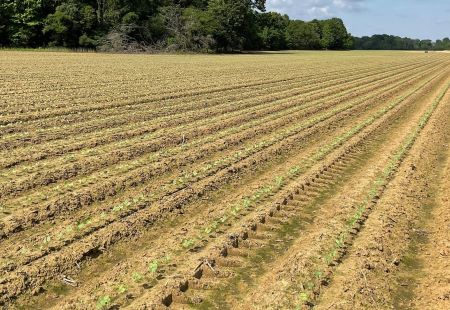Crop Scan Ag Report: Busy Time Has Arrived
That planting patience from two weeks ago is now history. Cotton planting is off and running across the entire Cotton Belt – even in parts of the High Plains where some recent rains provided planting moisture. Our contributing cotton consultants say there’s still a ways to go to get the entire crop in the ground, but it’s also not slowing down needed early season thrips treatments and herbicide applications.
Here’s their report for mid-May.
Wes Briggs consults on cotton, corn, peanuts, soybeans, and small grains for growers in Georgia, Alabama, and Florida.
Overall, cotton that has been planted so far has come up well, except for the very first cotton we planted that went through that cool weather about a month ago. We had to replant some of those fields. Since then, everything planted has come up fine. We’re seeing full stands in 5-7 days.
We still have a lot of cotton left to plant. We’re probably 30-35% finished now. Cotton planting ranges from seed still in the bag to 32 days old.
We’ve started a few herbicide applications along with our thrips treatments. Thrips pressure is not terrible, and we’re treating as needed where needed. On certain farms, thrips seem to be a little bit worse on our conventional rip-bedded land and not as heavy on some of the strip-till fields. You’d normally expect that to be the exact opposite.
Peanut planting is going good and they’re coming up well. Like cotton, planting ranges from seed in the bag to 33 days old. We’ve also started our first herbicide applications on peanuts.
We’re putting a little fertilizer out on cotton, peanuts, soybeans and corn. Our oldest corn field is 87 days old and silking.
Rain has been really hit or miss, but it is in the forecast for this week. Last week, some farms got rain every day, and other places maybe got a couple of tenths. We’ve had anywhere from a quarter inch up to five inches, depending on which side of the fence you’re on, I guess.
Chad Harrell owns and operates Harrell Agronomic Services in Northeastern North Carolina.
Planting progress is moving along in my area. Many growers finished up last week and have moved on to planting soybeans and peanuts. I would say as a whole we have about 80% of our cotton acres planted.
Expected rain over the weekend will likely slow progress for a couple of days, but we should have no problem finishing up before the end of the month. We are seeing good stand counts on the earliest planted cotton so far.
This upcoming week we will begin making thrips and herbicide applications.
Tucker Miller is a Mississippi-based independent private consultant for cotton, soybeans, corn, peanuts, rice, and vegetables.
A lot has happened in the last two weeks.
Most of our growers got in the field to plant cotton around May 4-5, with some growers maybe a few days earlier. Cotton was coming up in five or six days, looking healthy and strong. A lot of our growers got back in the field on May 14-15 and finished planting. We still have a few spots that need to dry up, and we can finish planting in a couple of days.
 Photo: Tucker Miller
Photo: Tucker Miller
Early season thrips have not been a problem yet. We will be watching closely due to the problems we had last year with resistance to some of our commonly used insecticides. We have been learning a lot about no-till and cover crops this year.
Most of our cotton looks good, with the exception of some weed problems where we couldn’t spray next to corn and soybeans with our pre-emerge and burndown applications.
Hope everyone can finish planting and has a great year.
Mark Nemec is an independent agricultural consultant for cotton, wheat, grain sorghum and corn in the Blacklands and Brazos River Bottom area of Central Texas.
We are still damp here in Central Texas. The off-and-on rains over the last several weeks have kept us from doing much in the fields. The sun has been out for two days, and the ground is now starting to crust. The forecast looks favorable for a while now – which is good because we have a lot to do.
We still need to replant some cotton as well as finish the rest of the original planting. The warmer weather has really helped the cotton take off in the higher ground. Thrips are our main concern now, as our wheat is drying down along with the winter weeds in the pastures and roadsides.
Speaking of weeds, there are plenty of them to go around. We will be applying herbicides as fast as we can when it dries up. One concern is going to be the size of some of the weeds. Several are going to be a little over the recommended height.
Kerry Siders is Texas A&M AgriLife Extension Agent-IPM for Hockley, Cochran, and Lamb Counties.
The Texas High Plains drought is not nearly over, but we have received rain showers over the last couple of weeks allowing for planting moisture. In fact, the moisture has caused many growers to delay getting started here at the end of the third week in May.
In terms of pests, we are finding increasing numbers of thrips. I would caution producers to really pay attention to those young cotton plants as they emerge. If protection from seed treatment or in-furrow treatments do not hold, then be prepared to use foliar treatments.
When we investigate nearby wheat fields, we find grasshoppers, plant bugs, and aphids along with good numbers of various beneficial insects. These pest situations are not a concern of possible things to come, but we need to be aware and stay abreast of how things develop over the next few weeks as the cotton plant develops and becomes more vulnerable.
We must also be vigilant against soil pests. Obviously, this is a field-by-field situation. So, if a field has a history of nematodes, hopefully you have taken measures to limit damage. Also, be on alert to wireworms which have developed the past few years. Stand development is very difficult when wireworms are present and have not been treated at planting.
So, be sure to walk your cotton fields as soon as they emerge and stay with it.















